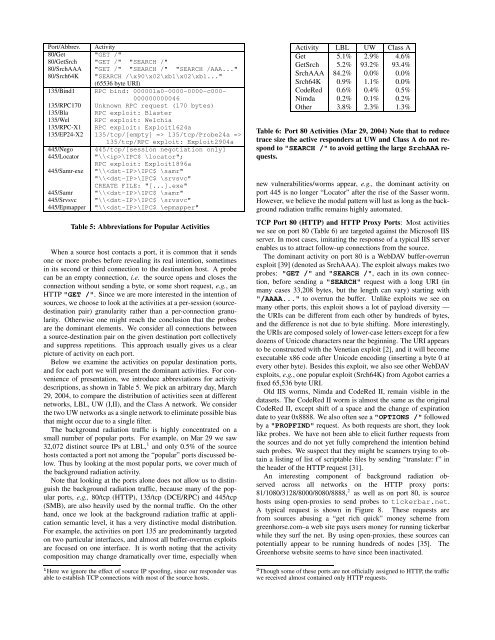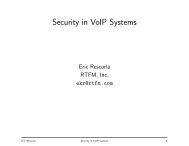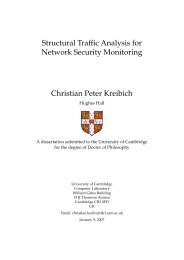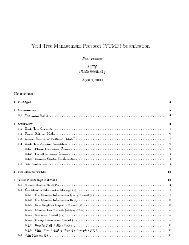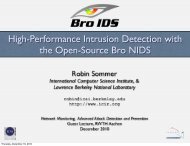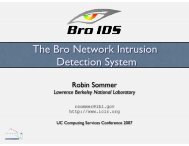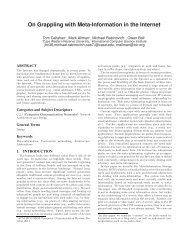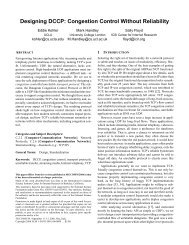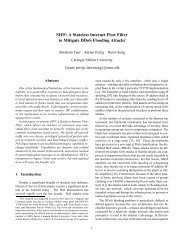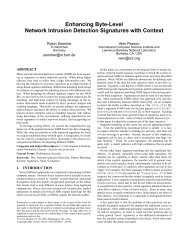Characteristics of Internet Background Radiation - UNC Computer ...
Characteristics of Internet Background Radiation - UNC Computer ...
Characteristics of Internet Background Radiation - UNC Computer ...
Create successful ePaper yourself
Turn your PDF publications into a flip-book with our unique Google optimized e-Paper software.
Port/Abbrev. Activity<br />
80/Get "GET /"<br />
80/GetSrch "GET /" "SEARCH /"<br />
80/SrchAAA "GET /" "SEARCH /" "SEARCH /AAA..."<br />
80/Srch64K "SEARCH /\x90\x02\xb1\x02\xb1..."<br />
(65536 byte URI)<br />
135/Bind1 RPC bind: 000001a0-0000-0000-c000-<br />
000000000046<br />
135/RPC170 Unknown RPC request (170 bytes)<br />
135/Bla RPC exploit: Blaster<br />
135/Wel RPC exploit: Welchia<br />
135/RPC-X1 RPC exploit: Exploit1624a<br />
135/EP24-X2 135/tcp/[empty] => 135/tcp/Probe24a =><br />
135/tcp/RPC exploit: Exploit2904a<br />
445/Nego 445/tcp/[session negotiation only]<br />
445/Locator "\\\IPC$ \locator";<br />
RPC exploit: Exploit1896a<br />
445/Samr-exe "\\\IPC$ \samr"<br />
"\\\IPC$ \srvsvc"<br />
CREATE FILE: "[...].exe"<br />
445/Samr "\\\IPC$ \samr"<br />
445/Srvsvc "\\\IPC$ \srvsvc"<br />
445/Epmapper "\\\IPC$ \epmapper"<br />
Table 5: Abbreviations for Popular Activities<br />
When a source host contacts a port, it is common that it sends<br />
one or more probes before revealing its real intention, sometimes<br />
in its second or third connection to the destination host. A probe<br />
can be an empty connection, i.e. the source opens and closes the<br />
connection without sending a byte, or some short request, e.g., an<br />
HTTP "GET /". Since we are more interested in the intention <strong>of</strong><br />
sources, we choose to look at the activities at a per-session (sourcedestination<br />
pair) granularity rather than a per-connection granularity.<br />
Otherwise one might reach the conclusion that the probes<br />
are the dominant elements. We consider all connections between<br />
a source-destination pair on the given destination port collectively<br />
and suppress repetitions. This approach usually gives us a clear<br />
picture <strong>of</strong> activity on each port.<br />
Below we examine the activities on popular destination ports,<br />
and for each port we will present the dominant activities. For convenience<br />
<strong>of</strong> presentation, we introduce abbreviations for activity<br />
descriptions, as shown in Table 5. We pick an arbitrary day, March<br />
29, 2004, to compare the distribution <strong>of</strong> activities seen at different<br />
networks, LBL, UW (I,II), and the Class A network. We consider<br />
the two UW networks as a single network to eliminate possible bias<br />
that might occur due to a single filter.<br />
The background radiation traffic is highly concentrated on a<br />
small number <strong>of</strong> popular ports. For example, on Mar 29 we saw<br />
32,072 distinct source IPs at LBL, 1 and only 0.5% <strong>of</strong> the source<br />
hosts contacted a port not among the “popular” ports discussed below.<br />
Thus by looking at the most popular ports, we cover much <strong>of</strong><br />
the background radiation activity.<br />
Note that looking at the ports alone does not allow us to distinguish<br />
the background radiation traffic, because many <strong>of</strong> the popular<br />
ports, e.g., 80/tcp (HTTP), 135/tcp (DCE/RPC) and 445/tcp<br />
(SMB), are also heavily used by the normal traffic. On the other<br />
hand, once we look at the background radiation traffic at application<br />
semantic level, it has a very distinctive modal distribution.<br />
For example, the activities on port 135 are predominantly targeted<br />
on two particular interfaces, and almost all buffer-overrun exploits<br />
are focused on one interface. It is worth noting that the activity<br />
composition may change dramatically over time, especially when<br />
Here we ignore the effect <strong>of</strong> source IP spo<strong>of</strong>ing, since our responder was<br />
able to establish TCP connections with most <strong>of</strong> the source hosts.<br />
Activity LBL UW Class A<br />
Get 5.1% 2.9% 4.6%<br />
GetSrch 5.2% 93.2% 93.4%<br />
SrchAAA 84.2% 0.0% 0.0%<br />
Srch64K 0.9% 1.1% 0.0%<br />
CodeRed 0.6% 0.4% 0.5%<br />
Nimda 0.2% 0.1% 0.2%<br />
Other 3.8% 2.3% 1.3%<br />
Table 6: Port 80 Activities (Mar 29, 2004) Note that to reduce<br />
trace size the active responders at UW and Class A do not respond<br />
to "SEARCH /" to avoid getting the large SrchAAA requests.<br />
new vulnerabilities/worms appear, e.g., the dominant activity on<br />
port 445 is no longer “Locator” after the rise <strong>of</strong> the Sasser worm.<br />
However, we believe the modal pattern will last as long as the background<br />
radiation traffic remains highly automated.<br />
TCP Port 80 (HTTP) and HTTP Proxy Ports: Most activities<br />
we see on port 80 (Table 6) are targeted against the Micros<strong>of</strong>t IIS<br />
server. In most cases, imitating the response <strong>of</strong> a typical IIS server<br />
enables us to attract follow-up connections from the source.<br />
The dominant activity on port 80 is a WebDAV buffer-overrun<br />
exploit [39] (denoted as SrchAAA). The exploit always makes two<br />
probes: "GET /" and "SEARCH /", each in its own connection,<br />
before sending a "SEARCH" request with a long URI (in<br />
many cases 33,208 bytes, but the length can vary) starting with<br />
"/AAAA..." to overrun the buffer. Unlike exploits we see on<br />
many other ports, this exploit shows a lot <strong>of</strong> payload diversity —<br />
the URIs can be different from each other by hundreds <strong>of</strong> bytes,<br />
and the difference is not due to byte shifting. More interestingly,<br />
the URIs are composed solely <strong>of</strong> lower-case letters except for a few<br />
dozens <strong>of</strong> Unicode characters near the beginning. The URI appears<br />
to be constructed with the Venetian exploit [2], and it will become<br />
executable x86 code after Unicode encoding (inserting a byte 0 at<br />
every other byte). Besides this exploit, we also see other WebDAV<br />
exploits, e.g., one popular exploit (Srch64K) from Agobot carries a<br />
fixed 65,536 byte URI.<br />
Old IIS worms, Nimda and CodeRed II, remain visible in the<br />
datasets. The CodeRed II worm is almost the same as the original<br />
CodeRed II, except shift <strong>of</strong> a space and the change <strong>of</strong> expiration<br />
date to year 0x8888. We also <strong>of</strong>ten see a "OPTIONS /" followed<br />
by a "PROPFIND" request. As both requests are short, they look<br />
like probes. We have not been able to elicit further requests from<br />
the sources and do not yet fully comprehend the intention behind<br />
such probes. We suspect that they might be scanners trying to obtain<br />
a listing <strong>of</strong> list <strong>of</strong> scriptable files by sending “translate: f” in<br />
the header <strong>of</strong> the HTTP request [31].<br />
An interesting component <strong>of</strong> background radiation observed<br />
across all networks on the HTTP proxy ports:<br />
81/1080/3128/8000/8080/8888, 2 as well as on port 80, is source<br />
hosts using open-proxies to send probes to tickerbar.net.<br />
A typical request is shown in Figure 8. These requests are<br />
from sources abusing a “get rich quick” money scheme from<br />
greenhorse.com–a web site pays users money for running tickerbar<br />
while they surf the net. By using open-proxies, these sources can<br />
potentially appear to be running hundreds <strong>of</strong> nodes [35]. The<br />
Greenhorse website seems to have since been inactivated.<br />
Though some <strong>of</strong> these ports are not <strong>of</strong>ficially assigned to HTTP, the traffic<br />
<br />
we received almost contained only HTTP requests.


